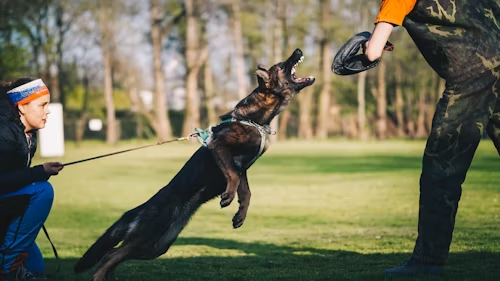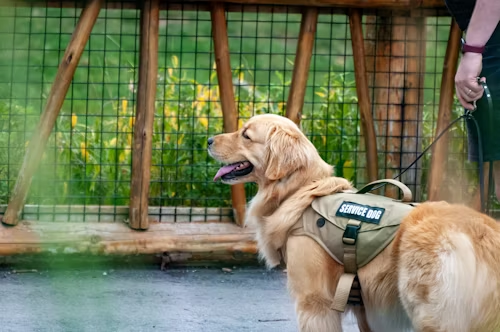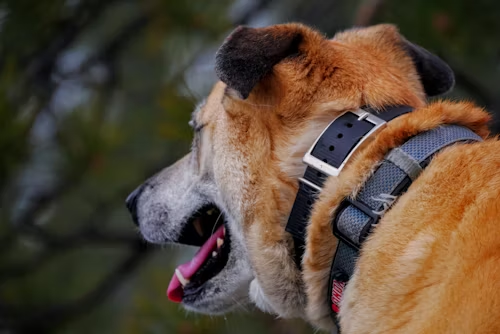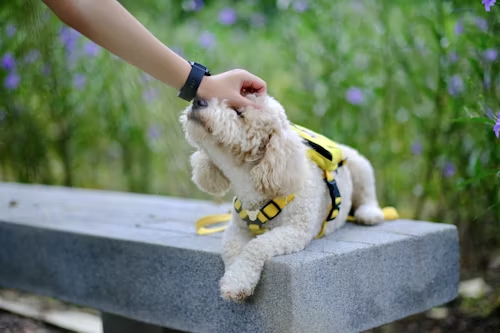If you have ever watched a dog walking calmly beside its owner and wondered how it happens, the answer often lies in one simple command: “heel.”
In dog training, heel is one of the most important obedience commands you can teach. It helps you maintain control during walks, ensures your dog’s safety, and strengthens the bond between you and your pet.
In this guide, I will explain exactly what heel means, why it matters, and how to teach it effectively, using practical steps that anyone can follow.
What is Heel Command
In dog training, the term “heel” refers to a dog walking close to the owner’s side, usually the left, while matching the owner’s pace.
A dog that heels stays aligned with your leg, maintains attention, and moves in sync with you. Essentially, when your dog is heeling, it is walking politely beside you, without pulling on the leash or getting distracted by its surroundings. This command is important for creating controlled, safe, and enjoyable walks, whether in a quiet neighborhood or a busy park.
Why Teaching Heel Is Important
Some dog owners consider the heel command advanced and skip it, but its benefits go far beyond appearances. Teaching your dog to heel gives you better control during walks.
It reduces the risk of accidents, such as your dog darting into traffic, and prevents situations where a leash could wrap around your legs. Beyond safety, the command encourages focus and patience, which strengthens your bond with your dog and improves overall behavior.
Dogs that learn to heel often become calmer and more obedient in other areas of life because they are learning self-control.
A Brief History of the Heel Command
The term “heel” originates from the alignment of a dog’s head or shoulder with the owner’s heel, traditionally the back of the left foot. Historically, this command was used in formal obedience training and with working dogs, where precise positioning was necessary.
Today, the heel command remains a foundation of obedience training and is widely used by pet owners to promote calm, controlled walking behavior.
Heel vs. Loose Leash Walking
It is important to distinguish between heeling and loose leash walking. When a dog is heeling, it walks precisely beside you with focus and alignment. Loose leash walking allows the dog to move comfortably on a relaxed leash while staying near you, but without strict alignment.
While both behaviors are valuable, the heel command is particularly useful in situations that require high levels of control, such as crowded areas or formal obedience settings.
When to Teach Your Dog to Heel
The heel command can be introduced once your dog has mastered basic obedience commands like “sit” and “stay.” Puppies under four months should have short, frequent sessions using treats and praise to maintain attention.
Older dogs can also learn to heel, though dogs with established pulling habits may require patience and consistency. Regardless of age, regular practice is the key to success.
How to Teach the Heel Command

Teaching your dog to heel is most effective with positive reinforcement. Begin by deciding which side your dog will walk on, usually the left.
Hold a small treat near your dog’s nose to gain attention and take a few slow steps forward while saying “heel.” Keep the treat at your thigh level so your dog stays beside you. Reward and praise your dog immediately when it follows correctly.
Practice short distances first and gradually increase the length of walks as your dog improves. Introduce turns and stops, rewarding the dog for maintaining position. Over time, reduce treats gradually, relying on praise to reinforce good behavior. Finally, practice in different environments, starting quiet and gradually adding distractions such as parks or sidewalks.
Common Mistakes to Avoid
Even experienced owners can make mistakes when teaching the heel command. To ensure success, watch out for the following:
- Pulling on the leash to force the dog into position, which can create resistance and anxiety.
- Using inconsistent commands or practicing irregularly, which can confuse the dog.
- Expecting perfect alignment from day one, leading to frustration.
- Short, inconsistent training sessions that don’t allow gradual learning.
- Neglecting positive reinforcement; relying on punishment instead of redirecting and rewarding correct behavior.
- Losing patience or being inconsistent, which can hinder progress.
Practical Applications of the Heel Command
The heel command is not just for formal obedience. It is valuable in everyday situations, including crossing streets safely, navigating crowded sidewalks, passing other dogs, visiting pet-friendly stores, and even in veterinary visits. In each of these scenarios, a dog that heels is safer, more comfortable, and more pleasant for both owner and pet.
Variations of the Heel Command
There are two main variations of the heel command: formal heel and casual heel.
Formal heel is typically used in competitions or advanced obedience training. In this version, the dog is expected to maintain perfect alignment with the handler’s side, staying focused and attentive at all times. The dog matches the handler’s pace precisely, stopping, starting, and turning exactly when the handler does.
This level of precision requires consistent practice and strong focus, making formal heel ideal for situations that demand strict obedience and discipline.
Casual heel, on the other hand, is more relaxed and practical for everyday walks. In this variation, the dog remains beside the handler without strict alignment, allowing for minor adjustments in pace or glances at the surroundings, as long as the dog stays under control.
Most pet owners use casual heel for daily walks because it is easier to maintain consistently while still promoting good leash manners and safety. Depending on training goals, both variations can be taught, allowing the dog to adapt to different environments and situations effectively.
Tools and Techniques to Support Training
| Category | Items/Notes |
|---|---|
| Essential Equipment | Comfortable collar or harness, standard 4–6 foot leash, small training treats |
| Optional Tools | Clicker (for precise reinforcement) |
| Avoid | Retractable leashes (encourage pulling, reduce control) |
Troubleshooting and Adjustments
If a dog pulls ahead, stop walking until it returns to position. If a dog lags behind, encourage it with voice cues and treats. For distracted dogs, shorten sessions and reward small successes. Regular reinforcement of eye contact helps maintain focus. Adjust your approach based on the dog’s responsiveness, temperament, and environment.
Psychological Benefits of Heeling
Dogs naturally explore their environment, so walking calmly beside you is a learned behavior that requires focus and impulse control. Training to heel improves a dog’s self-discipline, attention, and responsiveness, leading to calmer behavior at home and in public. A dog that heels also develops trust in its owner, understanding that following commands leads to rewards, safety, and social success.
Building a Strong Owner-Dog Relationship
Training is a form of communication. Teaching a dog to heel with positive reinforcement strengthens the bond by promoting trust and respect. Dogs learn that focusing on their owner brings benefits, which creates a harmonious dynamic. Walking together becomes not just exercise but a shared activity that builds cooperation and mutual understanding.
How Long Does It Take to Learn?
Learning the heel command varies by dog. Some may grasp it within a week, while others require several weeks or more to be reliable. Regular, short sessions are more effective than infrequent long sessions. Progress should be celebrated, and patience maintained. Consistency, rewards, and gentle correction ensure that the skill becomes permanent.






